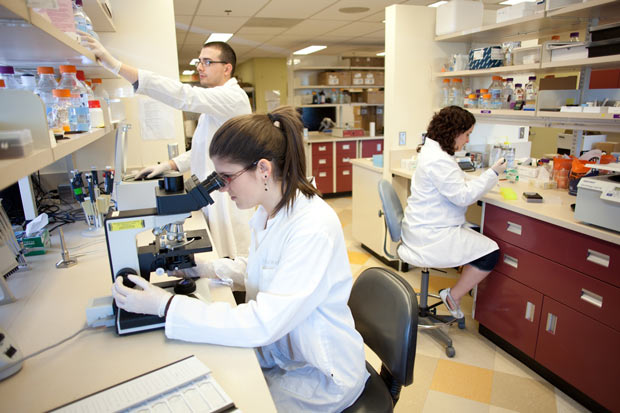

THUNDER BAY – Health – During the last two years, Dr. Ingeborg Zehbe, a scientist with the Thunder Bay Regional Research Institute (TBRRI) has worked closely with a dedicated team of young researchers. They include Robert Jackson, Sarah Niccoli, and Melissa Togtema. All three of these aspiring scientists have had their research recognized in publications such as the Journal of Virology, PLoS ONE, and IEEE Transactions on Ultrasonics, Ferroelectrics, and Frequency Control.
Research Impacts Patient Care
The research of Dr. Zehbe and her team focuses on infectious agents such as bacteria or viruses which have been identified as carcinogens. Her lab is interested in virus-related cancer using high risk, human papillomavirus (HPV) and skin or mucosa as a model.
How does studying papillomavirus oncoproteins, specifically HPV16 E6, benefit patient care? The complex, scientific term might make this research sound like it’s too far removed from helping patients. Quite the contrary, says Robert Jackson, Research Assistant with TBRRI.
“It has an impact on multiple levels: basic and clinical. For basic science, by studying HPV oncoprotein we are uncovering fundamental knowledge about its biology, evolution and function. Basic science serves as the foundation for which clinical science (which has more immediate results for patients) can be built”, says Jackson.
[sws_pullquote_right] “It has an impact on multiple levels: basic and clinical. For basic science, by studying HPV oncoprotein we are uncovering fundamental knowledge about its biology, evolution and function” [/sws_pullquote_right]
Jackson also explains that on the clinical science side of things, studying HPV oncoprotein allows researchers to improve patient care because it’s a target (or biomarker) that can be used for earlier and more effective diagnosis. Current diagnostic tests for cervical cancer include mainly pap tests and HPV DNA testing. While HPV DNA testing is an improvement over the traditional pap test, oncoprotein tests may be useful for diagnosing high risk infections that could develop into cervical cancer.
From a scientific method standpoint, the research on HPV oncoprotein that is being conducted at TBRRI is unique. “Although the HPV research community is large, we’re discovering new things and contributing these unique findings to the field”, says Jackson.
Sarah Niccoli, a former Research Assistant with TBRRI who is currently completing an internship at the Northern Ontario School of Medicine, shares much of her research with Jackson. She explains that oncoprotein variant research is an important part of HPV research.
“The benefit of testing for which oncoprotein variant is present is that different or more aggressive treatment options can be chosen based on the result”, says Niccoli. “In my research, I found that the Asian-American variant in particular is much more aggressive than the prototype with respect to how it affects our cells. This has also been suggested through its higher prevalence in cervical cancers in epidemiological studies. If this variant was found in a sample from a patient, it could be treated differently since risk is higher.”
Another unique aspect is the interdisciplinary environment that this research is being conducted in. Melissa Togtema, Research Assistant with TBRRI and full time graduate student, works closely with other scientists from different disciplines within the organization. “The ultimate end goal of my research is to develop a more targeted, less invasive treatment for HPV related cancers. This involves in depth collaboration with Dr. Samuel Pichardo and Dr. Laura Curiel, who are both engineers and proponents of HIFU technology”, says Togtema. “TBRRI likes to foster interdisciplinary collaboration. It’s definitely one of the advantages we have over larger research institutes”.






